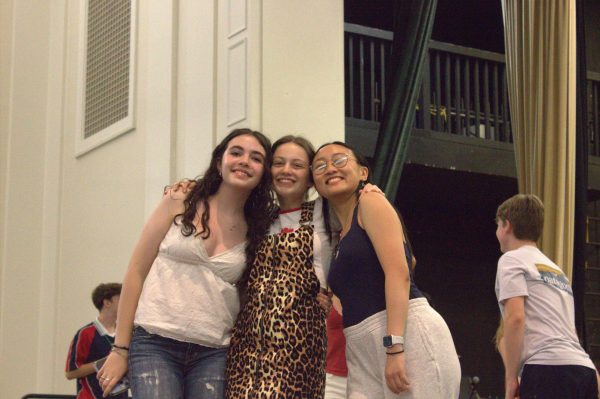Art history class creates art shows on campus
With a three-piece art exhibit and creative curriculum, the art history class has been busy this semester. So far, the three students have enjoyed the blend of subjects offered by the class, taught by Pamela Martinez. Currently, they are organizing an exhibition located around campus.
The class began the semester by discussing the work of Japanese architect Pecha Kucha. Matinez showed the class different slides that featured creative concepts in a presentation format. Next, the students participated in video interviews with students and faculty, asking the question, “What is art?” Inspired by internet comedians Rhett and Link, the brief, complex conversations with students and faculty gave the art history class the material to continue their study of the definition of art. The class has then developed their own art installation on campus.
“[We have] created a roving art show that students of all ages can interact with in the library,” said Martinez. “Now we are looking at the origins of the history of art since we have been investigating the personal and the contemporary for the past nine weeks.”
The class has rapidly been developing their ideas of art through their project.
“We jumped straight into curating this project,” said senior Meghan Cobler. “But we’ve also gone on a field trip to the art museum, and are going to do a bunch of different trips this semester.”
The class has also had different speakers come to the class, including Beth Malone, a space-centered art curator.
“It helped us figure out what curating art really is,” said sophomore Iris Yin. “It inspired me to look deeper into curating art.”
The current project, consisting of three unique art exhibits, lets viewers interact with the art forms and catch a glimpse of the art history class. One exhibit, organized by Yin, is located on Broyles Field. Yin chose landscape paintings as the central focus of her project.
“I [was] inspired by a Caspar David Friedrich piece called Wanderer Above the Sea of Fog,” said Yin. A key figure in the nineteenth-century German Romantic movement, Friedrich draws fame from his metaphorical landscapes, which show his fascination with nature. Yin’s exhibition consists of two different picture frames: one of sun and mountains, painted by her father, and one where the viewer can choose their own landscape.
“I chose landscapes, specifically mountains, because of how humbling they are,” said Yin. “They allow you to take a step back and realize what’s important in your life.”
The students each focused on a specific artist in order to thoroughly capture their genre of art. Senior Meghan Cobler’s project centers on surrealism, and chose works by artist Kay Sage to echo the different fantastical planes of the art form.
“It’s like an interactive exhibit on realism,” said Cobler. “It’s about her life.”
The third exhibition is curated by sophomore Mason Wright. Sited on the bottom floor of library, Wright’s project focuses on abstract expressionism and centers on pieces by Mark Rothko and Jackson Pollock. Pollock, the primary influence behind the abstract expressionist movement in the art world, used a paint-splattering technique that immediately drew Wright to his work. The Rothko painting Wright used shows the art form of color field, while Pollock’s shows action. In his exhibit, Wright employs questions to help viewers interact with the art.
“A lot of critics didn’t know what to think of Pollock’s work when it first came out,” said Wright. “I found it really interesting that a controversial artist could become one of the most influential artists of the 20th century.”
The students appreciate the freedom the art show provided.
“I loved curating the art show because you got to decide what to put and where to put it,” said Cobler. “You [were allowed] to chose anything.”
Furthermore, the small size of the art history class delivers unique benefits unable to be achieved by classes with more students.
“I like having a small class because it offers more flexibility,” said Yin. “For example, we have been able to go on field trips rather easily.”
The unique size also gives the class a close relationship.
“The three of us in the class have become very close,” said Cobler.
The class has also provided an opportunity for the students to contemplate their own opinions of art.
“The class has broadened how I think about art,” said Wright. “I can’t wait to continue my artistic exploration into the next several years of my art classes.”





